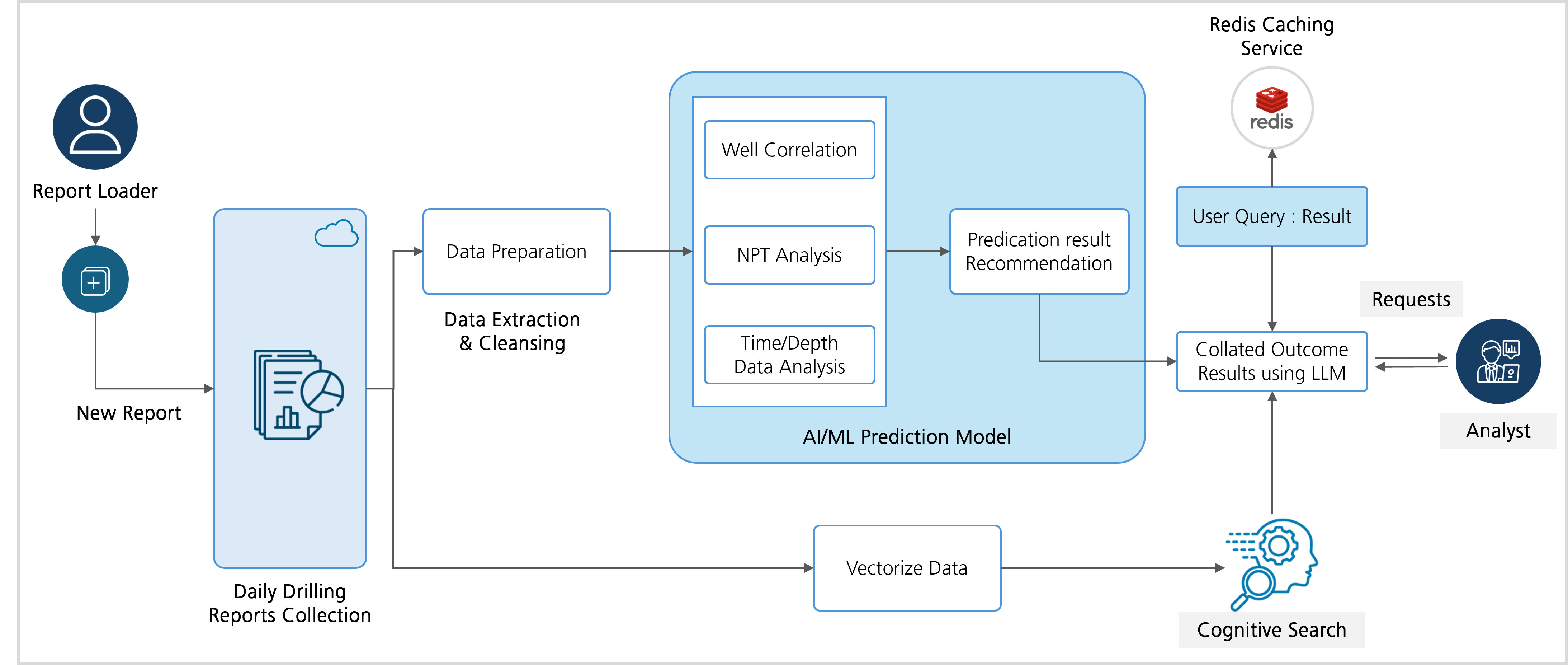Introduction
In the upstream oil and gas industry, drilling each well is a high-cost, high-risk operation, especially offshore, where costs can exceed a million dollars per well. Delays caused by poor planning, geological uncertainty, or missed insights can result in significant financial loss.
Drilling engineers rely on historical data from nearby wells, captured in reports such as daily drilling logs and well completion summaries, to mitigate risks. However, these documents are often unstructured, requiring manual review and slowing down decision-making.
Gen AI offers a transformative way forward. Automating the extraction of relevant insights from daily drilling reports (DDRs) helps engineers identify hazards, optimize parameters, and accelerate planning. Solutions such as chatbot-based search systems for geological data enable teams to make faster, smarter drilling decisions, minimizing risks and maximizing resource utilization.
Why is non-productive time costing you millions, and how to fix it?
Non-productive time (NPT) in oilfield operations refers to periods when drilling or production activities are paused or do not contribute to project goals. NPT can account for up to 20% of the overall project time, costing millions of dollars in delays. You may see the image below (Figure 1) as an example breakdown of drilling-related NPT.
Figure: An example breakdown of drilling-related NPT
Common causes include equipment failures, well instability, poor weather, safety incidents, logistics delays, and regulatory compliance issues. Reducing NPT is critical to improving cost-efficiency and speed of drilling operations. A study mentions that NPT can leverage around 13% in drilling operations over the years. This highlights the significant portion of time lost due to non-productive activities.
Understanding daily drilling reports
A daily drilling report (DDR) is a key document contractors create during each drilling day; It captures essential information such as the well name, location, depth, lithology, work performed, hydrocarbons detected, and other operational data.
nalyzing DDRs helps uncover patterns that lead to NPT, enabling preventive action before NPT disrupts operations. These reports are vital for monitoring drilling performance, tracking efficiency, and ensuring regulatory and contractual obligations compliance.
Applying generative AI to optimize drilling insights
Analyzing drilling reports is critical to reducing risk and non-productive time in oil and gas exploration. These reports vary across operators and often come in unstructured formats, making manual analysis time-consuming and error prone. Essential indicators, such as hidden NPT events or risk factors, can be missed in the process.
How generative AI helps
Gen AI tools, especially those built on large language models (LLMs), streamline this process by automating insight extraction. These models can scan DDRs, identify patterns, and flag anomalies that might go unnoticed. Risk factors and NPT events can be detected earlier, allowing engineers to make proactive decisions faster and more accurately.
What drilling engineers can do with this?
One common use case is optimizing drilling parameters like Rate of Penetration (RoP), Weight on Bit (WoB), rotary speed, and hook load. Instead of relying solely on experience, engineers can now use insights from multiple historical reports, often across different wells in the same basin.
Gen AI can also tap into industry-standard Systems of Record (SoRs) to gather relevant drilling data and generate immediate, context-aware recommendations. By doing this, gen AI doesn’t just reduce manual work. It enhances safety, shortens analysis time, and helps engineers build more reliable drilling plans. Ultimately, it leads to lower costs, improved well performance, and more predictable operations.
Workflow powering drilling optimization
The workflow begins with collecting DDRs from the area of interest. These reports undergo a data preparation phase to ensure accuracy and readiness for analysis. Well correlation follows, identifying patterns across historical data. The next critical step is extracting relevant risk information from drilling event descriptions in the reports.
Gen AI models, especially those using retrieval-augmented generation (RAG), help improve data quality by automating insight extraction. Engineers can interact with a cognitive search interface to query specific results. These are processed using an LLM, which generates detailed outcomes.
While commercial models like ChatGPT work well for common events, fine-tuning is needed to capture rare drilling classes. A caching service such as Redis ensures faster response times by storing frequently accessed queries.
AI/ML models trained on historical data help establish correlations and assist in drilling planning. This leads to faster, more accurate recommendations for drilling engineers, enhancing safety, reducing risk, and optimizing drilling operations. The conceptual workflow described above is shown below.

Figure: Conceptual workflow for drilling optimization from DDR’s using gen AI interventions
Business values and impact
- Time efficiency: Gen AI solutions can process more than 100 drilling reports within hours, reducing manual analysis time from 15-20 days to just a few hours, saving engineers critical planning time.
- Enhanced accuracy: Fine-tuned LLMs help spot minor incidents or anomalies often missed during manual reviews, leading to more reliable assessments.
- Data-driven insights: Gen AI helps engineers uncover early warning signs and make faster, smarter drilling decisions by identifying patterns across large datasets.
- Cost control: Optimized drilling plans reduce rig downtime, equipment damage, and compliance penalties, resulting in measurable cost savings.
- Safety operations: Gen AI’s early detection of risks improves worker safety by enabling preventive measures before an incident escalates.
- Scalability: AI models adapt across drilling projects and geographies, offering a repeatable solution for complex data environments.
Conclusion
Gen AI redefines how oil and gas companies plan and execute drilling operations. Extracting insights from DDRs enables faster decision-making, reduces NPT, and enhances operational efficiency. With its ability to surface hidden risks and optimize drilling plans, gen AI helps teams lower costs, improve safety, and future-proof their operations.
References
2 DTU Orbit, A Drilling Company’s Perspective on Non-Productive Time NPT Due to WellStability Issues, Natalia Krygier, 2020: https://orbit.dtu.dk/en/publications/a-drilling-companys-perspective-on-non-productive-time-npt-due-to